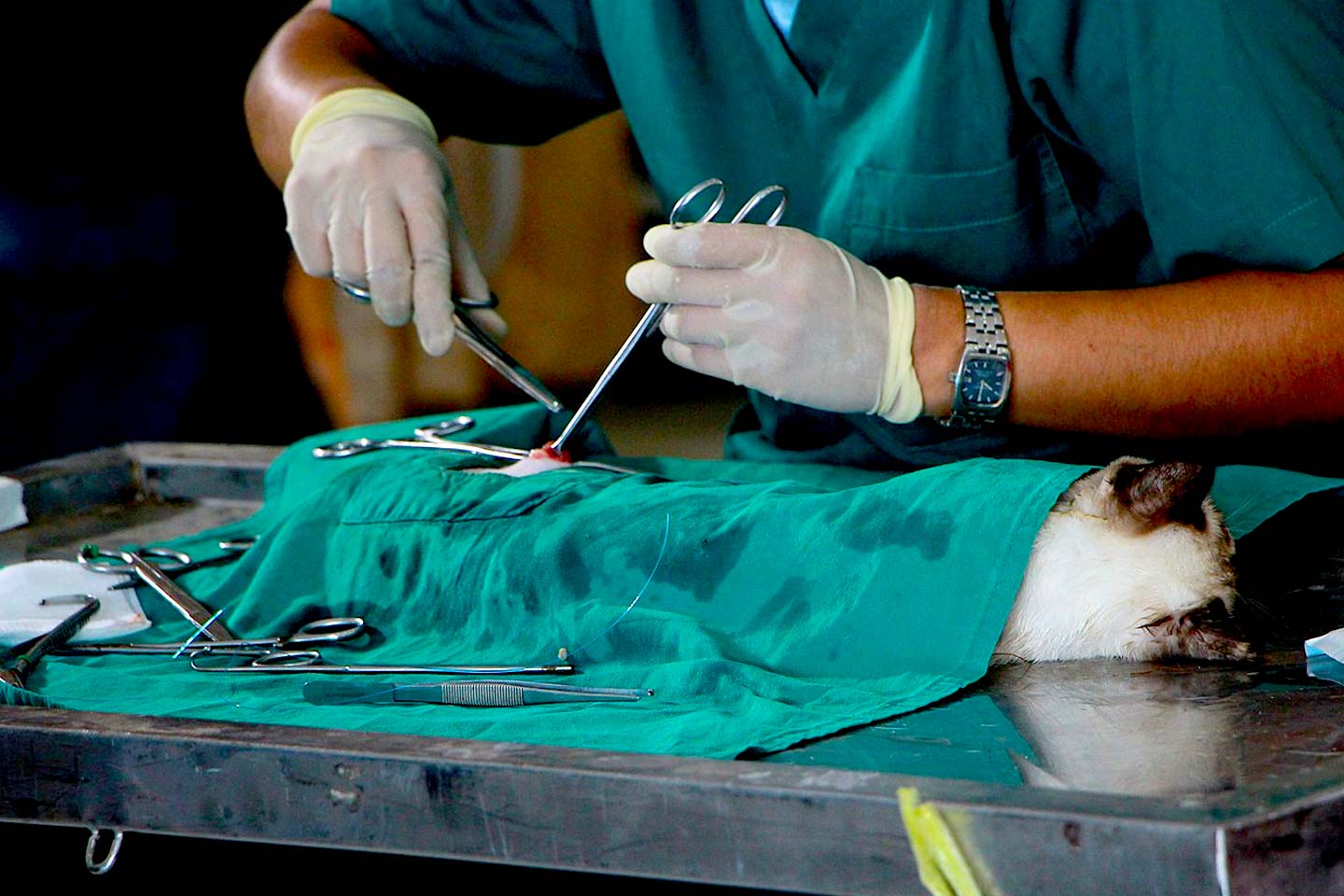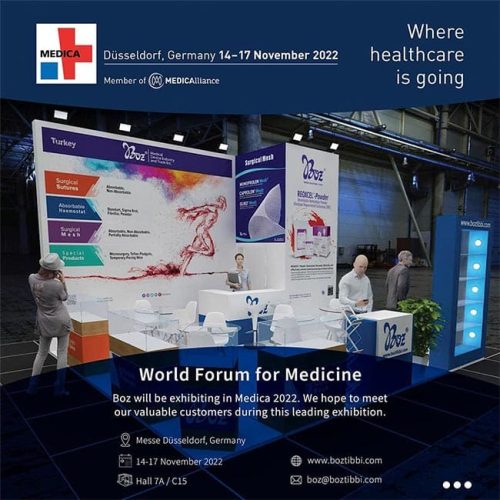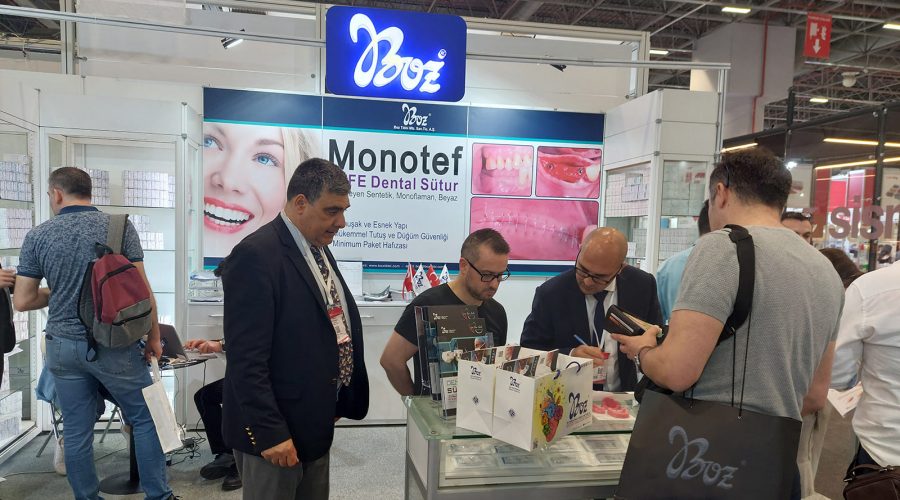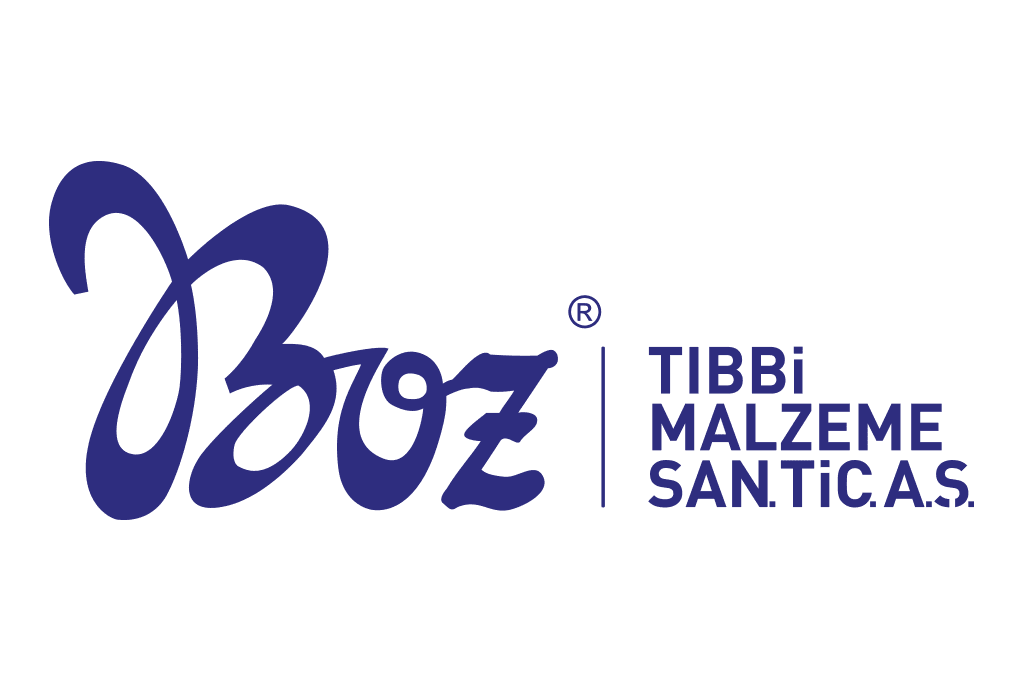Sutures are used in the surgical operations to connect the injured tissues or tissue incisions. With today’s technological opportunities, it is possible to manufacture various suture products. Each of these sutures are preferred for different surgical operations depending on the suture properties. The support of the sutures in tissue recovery plays an important in veterinary surgery. Click here to learn more about veterinary surgery suture properties and click here to learn more about suture techniques. When choosing a suture, scar/incision conditions as well as physical, chemical, and biologic properties of the sutures should be considered. In this article, we will talk about the veterinary sutures.
We can considered veterinary sutures under 2 separate titles:
1. Absorbable Sutures
- Catgut
- Polyglycolic acid (PGA)
- Polydioxanone (PDS)
- Poly Glycolide Caprolactone (PGCL)
2. Non-absorbable sutures
- Silk
- Nylon
- Polypropylene (PP)
- Stainless steel wire
- Polyester (PET)
Absorbable Veterinary Surgery Sutures
Absorbable sutures lose tensile strength in the following 60 days after implementation. These sutures are absorbed by the defence system of the body (1, 2) and almost all of these sutures lead to partial tissue reaction (1). However, these sutures are degraded with non-enzymatic hydrolysis. In synthetic suture hydrolysis, polymer structure is degraded into monomer structure with the direct effect of the water and the monomer structure is metabolised into carbon dioxide with water. With these properties, synthetic sutures do not have visible effect on absorption rate in case of infection or inflammation (2).
Catgut
Most of the synthetic sutures are formed by polymerising the liquid resin; silk suture formed from natural fibres is formed by bending and catguts are formed by stratification and bending after creating stripe forms (1, 2, 3). Catgut is a naturally absorbable multifilament suture obtained from lamb intestine submucosa or cattle intestine serosa (2, 5, 6, 7, 11, 12, 3). Jejunum and ileum are used as intestine (7). This is the most common suture in the veterinary surgery even though synthetic sutures are developed today (6). After implemented to the tissues, the suture can be degraded in enzymatic way, absorbed by phagocytosis and always cause an inflammatory reaction (2, 6, 8). It is known that catguts lead to more intense tissue reaction in cats more than dogs (1). When a normal catgut is implemented to the tissue, the 50% of the tensile strength is lost on the 1st day and entire tensile strength is lost between day 3 and 7 (6). the suture is completely absorbed between 10-14 days (1, 9). Normal catgut is formed as chromium catgut by processing with chromic salts to increase the strength and to decrease the tissue reaction by increasing the degrading period (2, 3, 6, 7, 9, 10). At the end of the processing with chromic salts, the intermolecular bonds increase and the suture gains a good strength (6). Chrome catguts lose the entire tensile strength in 21-28 days after implantation (2). The complete absorption duration varies between 20-40 days. It is reported that catguts are absorbed faster in case of infection (1, 2, 6), tissues with high blood flow (1, 6) and tissues with organ enzymes such as pancreas and intestine (1) (6). Additionally, catguts have capillary properties. However, this suture is used in gastrointestinal and urogenital system, parenchymatous organs (11), vein ligatures, muscle and facia sutures (3). The skin and nerve tissue use of catguts are contraindicated (11). Due to hydrophobic properties, the knots tend to get lose since the water is absorbed (1, 2 , 6). Therefore, 3 or more knots are necessary (1, 11) and the sutures cut after the knot must be longer than the other types of sutures (1, 6). To soften the hard structure, some firms pack this suture in 85% alcohol (6.10).
Polyglycolic acid (PGA)
This is a multifilament and braided synthetic polyester suture material made from polymeric hydroxy acetic acid (1, 2, 11). Polyglycolic acid sutures are coated with polycaprolate for easier use and easier implementation on the tissues (1, 2 ) but the knot security is decreased with this coating. Compared to catgut, the tensile strength and knot security are better, the resorption duration is longer and the tissue reactions are lower (1, 2, 9). However, tensile strength is lower than other absorbable synthetic sutures. Since use in oral cavity and in case of infected urine (due to alkaline pH) increases the suture degradation rate, this suture is not suitable for these conditions (2). The suture loses the 33-40% of the tensile strength on the 7th day after implantation (15, 9, 10), 65-80% on the 14th day (10, 1, 9, 11), 95% on the 28th day and completely resorbed on 90-120 day via hydrolysis (1, 9, 10, 11). Polyglycolic acid sutures are suitable for intestine anastomosis, C-section operations, hernia and tissues that do not require long-term support (2).
Polydioxanone (PDS)
This is a monofilament absorbable synthetic suture (2, 6, 11) formed from paradioxanone polymer (2, 13). PDS is stronger than other synthetic absorbable sutures and absorbed slower. Therefore, this suture leads to less reaction on the tissues. This suture can be applied on contaminated scars or scars with infection risk (6, 10). PDS is successfully used for sterile and infected urine in the dog’s bladder (1). Since polydioxanone is hard, manipulation is hard (1, 5, 10, 11) and knot security is low (1, 9, 10). After implantation, the suture loses 26% of the tensile strength on the 14th day, 50% on the 28th day, 86% on the 59th day and the suture is completely absorbed 180 days after the implantation (1, 9).
Poly Glycolide Caprolactone (PGCL)
Poly Glycolide Caprolactone (PGCL) is a monofilament absorbable suture made from epsilon caprolactone and glycolide co-polymer (2). Although it has a monofilament structure, handling, pliability and know security are good (1, 2, 10, 14). This suture leads to minimal reaction on the tissues (3, 14, 15). The suture can easily pass through the tissues and do not have capillarity (2). This suture is more durable than the catgut at the beginning. However, the tensile strength decreases rapidly after implanted to the tissue. The tensile strength 14 days after the implantation is equal to or more tan catgut and chrome catgut (12). After the implantation, the undyed version loses 40% of the tensile strength on the 7th day, 70-80% on the 14th day and completely absorbed between 90 to 120 days (10). This suture is recommended for linea alba (2), subcutaneous (12) and soft tissue closure and various ligature applications in cats (2, 12).
Non-Absorbable Veterinary Surgery Sutures
Non-absorbable sutures preserve the tensile strength for more than 60 days after the implantation (18, 36, 37) and are not degraded as significant level (2). However, silk and multifilament nylon sutures among non-absorbable sutures lose the majority of the tensile strength 4-6 weeks after the implantation (4). Non-absorbable sutures are used for scars that require long-term support. While natural non-absorbable sutures tend to create significant tissue reaction, synthetic sutures lead to less tissue reaction. Common non-absorbable suture materials used in the veterinaries are:
Silk
This suture is produced from silkworm larva and it consists of protein fibres and braided structure (9, 11, 13). The original colour of silk is white. However, the suture is dyed to black or green colour to be easily visible during the operation (6). Silk suture that leads to intense tissue reaction (2, 9, 15) has significant capillary property due to multifilament structure (2, 9, 11). However, the silk suture is coated with wax or silicon to decrease the capillary property (5). On the other hand, this suture must be used for infected scars (1, 6, 9, 11) and epithelium coated hollow organs (1) due to its capillary property. Although synthetic sutures have the perfect biologic properties, silk suture is popular in veterinary surgery due to good manipulation and knotting capacities (2, 6, 11). Silk sutures have the lowest tensile strength among the sutures that are used today (9). Although it is classified as non-absorbable suture, 50% of the tensile strength is lost in 1 year after the implantation (2) and the suture is entirely absorbed in approximately 2 years (1, 2, 10). It is known that the suture might lead to ulcer when used in gastrointestinal system and stones when used in urinary system and gallbladder channels (2).
Nylon
Nylon sutures are thermoplastic derivatives that contain hexamethylenediamine and adipic acid amine. These sutures have monofilament and multifilament forms (1, 2). The most common type is monofilament form (6). The monofilament sutures lose the tensile strength in 2-3 years after implanting to tissues and multifilament sutures lose the tensile strength in 6 months (10). Nylon sutures have the perfect elasticity property (9). Monofilament sutures are hard to handle and have low knot security (1, 10). Additionally, the thing ones may cut the tissue (10). Multifilament sutures are easy to handle but these have capillary properties (1) and lead to more tissue reaction (10). In case of infection, monofilament nylon sutures can be easily used (6). When used in serosa and synovial cavities, the suture end inside the tissue might lead to irritation (1).
Polyester (PTFE)
This suture is made from polyethylene terephalate. This suture is stronger than silk and catgut (2) but have weak know security (1). Polyester causes trauma when passed through the tissues (10). Polyester sutures are coated with polybutylene to reduce the trauma and to make the manipulation easier (2).
Polypropylene (PP)
This is a monofilament non-absorbable suture made from polypropylene stereo isomer. The tensile strength is lower than other synthetic non-absorbable sutures (4). The suture has low handling and knot safety but high memory (21, 27, 28, 39) (1, 2, 9, 11). More knots are necessary to prevent the unknotting and the knots must be melted with thermocautery. Since the suture has low friction coefficient, it can easily pass through the tissues (10). This suture has plasticity property (1, 10). It is commonly used in vascular surgery (1).
Stainless Steel Wire
These are molybdenum, nickel and chromium alloy (10). It is a biologically inert material (2, 15). These sutures have monofilament and multifilament forms (6, 11). This suture is more durable than all other sutures (5, 6, 11). The suture does not have capillary property (1). This suture is commonly used in orthopaedic surgery (2) and tendon and ligament repair (1). Additionally, it can be used in contaminated and infected wounds (10). The manipulation is hard (6, 11) and the operator’s glove might be punctured during manipulation (6). Additionally, this suture tends to cut the tissues (1, 2, 6, 11) and might break when bend too much (1). It is not elastic and knotting is hard (11). Veterinary surgeons rarely use this suture (6).
Bibliography
(1) Niles J, Williams J (1999): Suture Materials and Patterns, In Practice, 21:308-20
(2) Tan R, Bell R, Dowling B, Dart A (2003) Suture Materials; Composition and Applications in Veterinary Wound Repair, Aust Vet J, 81(3):140-45
(3) Hickman J, Houlton JEF, Edwards B (1995): An Atlas of Vet Surg, 3 nd Ed, Blackwell Science, Cambridge
(4) Smeak, DD (1990): Selection and Use of Currently Available Suture Material, (in) Current Techniques in Small Animal Surgery, MJ Bojrab (Editor), chapter 3, 3nd Ed, Lea & Febiger, Philadelphia
(5) Stashak, TS (1991): Equine Wound Management, Lea & Febiger, Malvern, Pennsylvania
(6) Turner AS, McWraıth CW (1995): Techniques in Large Animal Surgery 2nd Ed, Lea & Febiger, Philadelphia
(7) Chu, CC (2001): Textile-Based Biomaterials for Surgical Aplications. (in) Polymeric Biomaterials Second Edition Revised and Expanded, S. Dumitriu, (Editör) Chapter 19, Marcel Dekker, New York.
(8) Sherbeeny, AM (2004): Needdles, Sutures and Knots Part III: Spesific Suture Materials, ASJOG, 1:167-70
(9) Moy RL, Lee A, Zalka A (1991): Commonly Used Suture Materials in Skin Surgery, Am Fam Physician, 44(6):2123-8
(10) Terhune, M (2002): Materials for wound closure, http://www.emedicine.com
(11) Knecht CD, Allen AR, Willıams DJ, Jonhson (1987): Fundamental Techniques in Vet Surg, 3nd Ed, WB Saunder Company, Philadelphia
(12) Henderson, RA (2005). The Veterinarian’s Suture Guide http://www.vetmed.auburn.edu
(13) Mc Ilwraith CW, Turner AS (1987): Equine Surgert Advanced Techniques, Lea& Febiger, Malvern, Pennsylvania
(14) Sylvestre A, Wilson J, Hare J (2002): A Comparison of 2 Different Suture Patterns for Skin Closure of Canine Ovariohysterectomy, Can Vet J, 43:699–702
(15) Greenwald D, Albear P, Gotlieb L (1994): Mechanical Comparison of 10 Suture Materials Before and After in Vivo İncubation, J Surg Res, 56: 372-7





